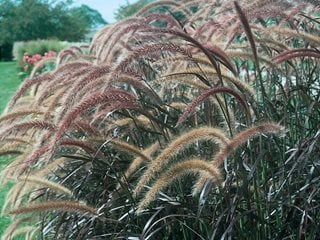Purple Fountain Grass - Growing & Care
With its flowing fountain shape, colorful foliage, and bottlebrush plumes throughout summer and fall, purple fountain grass can add contrasting shape and texture, as well as movement in your garden. Its tall plumes rise above the clumping grass and sway in the breeze. This rapid-growing plant requires little maintenance and is deer resistant.
On this page: Basics | Planting & Care | Design Ideas | Is it invasive?
BASICS
Botanical name:
Pennisetum setaceum 'Rubrum'
Common name:
Purple fountain grass
Zones:
9 to 11, grown as an annual in colder climates
Height/Spread:
3 to 5 feet tall and 2 to 4 feet wide
Exposure:
Full sun to partial shade
Soil:
Average, well-drained
Water:
Medium, consistent water throughout growing season
Color:
Burgundy-red leaves, burgundy-purple flowers in bottlebrush-like spikes
Bloom time:
July to October
Diseases and Pests:
No serious insect or disease problems.
PLANTING & CARE
When to Plant:
If you are planting in the fall, do so at least a month before the average first frost.
Water:
While they will tolerate dry conditions and are quite drought resistant, purple fountain grasses will look their best with regular watering.
Pruning:
In areas where purple fountain grass is being grown as a perennial, it should be cut back to just a few inches above the ground in late winter or early spring before new growth begins to ensure a full and healthy plant. Cutting back will also decrease the fire danger as fountain grass turns brown and dry in winter and becomes extremely flammable.
DESIGN IDEAS
Purple fountain grass makes a dramatic statement no matter where it is used:
- Foundation plant for a larger grouping
- Alone as a specimen
- Accent in perennial beds and borders
- Alone or as a centerpiece for a container
- In a desert or rock garden
- Ground cover
- Median strips, parking lot borders, and erosion control
IS PURPLE FOUNTAIN GRASS INVASIVE?
Some varieties of pennisetums will readily self-seed and become invasive in the warmer areas where they are grown as perennials. However, according to Missouri Botanical Garden, “‘Rubrum’, sometimes commonly called purple or red fountain grass, is a burgundy-red leaved cultivar that is not invasive under any circumstances because, unlike the species, it rarely sets seed.” However, be careful if you grow several cultivars together because with cross-pollination, you might get viable seed.
Other colorful non-invasive ornamental grasses:
'Fireworks’ (variegated red fountain grass) has bright, red and green variegated leaves with purple tassels and is slightly smaller than ‘Rubrum’. 'Sky Rocket' has green and white striped foliage with white plumes, and is also slightly smaller than 'Rubrum'.
RELATED:
18 Top Ornamental Grasses
How to Grow & Care for Fountain Grass
Ornamental Grasses
Grasses as Container Plants




